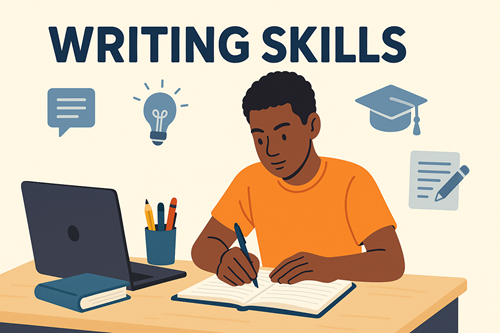Writing Skills

The writing process begins with a spark of inspiration, often accompanied by the thrill of possibility. Every good writer typically starts with brainstorming, jotting down thoughts and themes that resonate with them. This is followed by outlining, where the structure of the piece begins to take shape. As the initial draft emerges, the focus shifts to putting words on the page without the constraints of perfection.
Revision is where the magic happens—refining language, enhancing clarity, and polishing the narrative. Finally, editing ensures that grammar and style are harmonious, preparing the piece for its audience. Throughout this process, patience and persistence are essential, as every draft brings the writer closer to their intended purpose.
Writing generally consists of three main stages: Pre-writing, Writing, and Post-writing. Many writers and linguists believe that pre-writing activities account for fifty percent of the total work involved in writing. These pre-writing activities are essential steps that help writers generate ideas, plan their content, and organize their thoughts before drafting a piece of writing. Here are some common pre-writing activities:
1. Brainstorming: Generating a list of ideas related to the writing topic, either individually or in a group.
2. Free Writing: Writing continuously for a set period without worrying about grammar or structure. This helps unlock creativity and explore thoughts.
3. Mind Mapping: Creating a visual representation of thoughts and ideas, with the main topic at the center and related concepts branching out.
4. Outline Creation: Structuring the main points and arguments in a logical order. An outline serves as a roadmap for the writing.
5. Research: Gathering information, data, or inspiration from various sources to support the writing project.
6. Questioning: Write down questions related to the topic to guide the content and direction of the piece.
7. Listing: Creating lists of ideas, themes, or points to be included, which can later be expanded into full sentences.
8. Role Play or Perspective Taking: Imagining different viewpoints to explore how various perspectives might shape the writing.
9. Clustering: Similar to mind mapping, clustering involves writing a word in the center and circling related ideas, further exploring connections.
10. Storyboarding: For narrative writing, storyboarding involves arranging key scenes or arguments visually, helping with pacing and flow.
Engaging in these pre-writing activities can lead to more focused and coherent writing, making the drafting process smoother.
For secondary school writing—especially during examinations—thorough practice is essential to cultivate well-organized, coherent, and purposeful writing. In this context, topics are often narrow and pre-defined, which we can refer to as guided writing. You write to meet the requirements of the given topic within a set time frame.
Regardless of the situation, you should still take at least ten minutes to do the “fifty percent of the work” for your write-up. Therefore, dedicate time for brainstorming, drafting, and mind mapping. This approach will help you identify the ideas relevant to the topic at hand, the sequence of your arguments, and the variety of sentence structures to ensure clarity.
With this preparation, you will craft a write-up that will impress any examiner.
